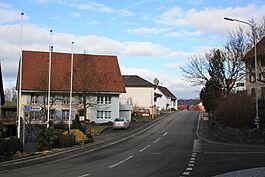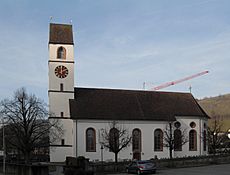Mettauertal facts for kids
Quick facts for kids
Mettauertal
|
||
|---|---|---|
 |
||
|
||
| Country | Switzerland | |
| Canton | Aargau | |
| District | Laufenburg | |
| Area | ||
| • Total | 21.59 km2 (8.34 sq mi) | |
| Elevation | 381 m (1,250 ft) | |
| Population
(Dec 2020 )
|
||
| • Total | 2,067 | |
| • Density | 95.74/km2 (247.96/sq mi) | |
| Postal code |
5276
|
|
| Surrounded by | Gansingen, Laufenburg, Leibstadt, Leuggern, Mandach, Remigen, Schwaderloch, Villigen | |
Mettauertal is a municipality in the district of Laufenburg in the canton of Aargau in Switzerland. On 1 January 2010 the municipalities of Hottwil, Etzgen, Mettau, Oberhofen and Wil merged to form the new municipality of Mettauertal.
Contents
Geography
Mettauertal had an area, (as of the 2004/09 survey) of 21.59 km2 (8.34 sq mi). Of this area, about 51.2% is used for agricultural purposes, while 40.1% is forested. Of the rest of the land, 7.5% is settled (buildings or roads) and 1.3% is unproductive land. Over the past two decades (1979/85-2004/09) the amount of land that is settled has increased by 26 ha (64 acres) and the agricultural land has decreased by 36 ha (89 acres).
Demographics
Mettauertal has a population (as of December 2020[update]) of 2,067. As of 2013[update], 11.3% of the population are resident foreign nationals. Over the last 3 years (2010-2013) the population has changed at a rate of -1.39%. The birth rate in the municipality, in 2013, was 9.4 while the death rate was 5.2 per thousand residents.
As of 2013[update], children and teenagers (0–19 years old) make up 18.8% of the population, while adults (20–64 years old) are 62.4% and seniors (over 64 years old) make up 18.7%.
Historic Population
The historical population is given in the following chart:

Heritage sites of national significance
The Hottwil, a former untervogtei residence with outbuildings and the catholic parish church in Mettau are listed as Swiss heritage sites of national significance.
Economy
As of 2012[update], there were a total of 807 people employed in the municipality. Of these, a total of 150 people worked in 56 businesses in the primary economic sector. The secondary sector employed 361 workers in 41 separate businesses. Finally, the tertiary sector provided 296 jobs in 91 businesses. In 2013 a total of 8.9% of the population received social assistance.
See also
 In Spanish: Mettauertal para niños
In Spanish: Mettauertal para niños






